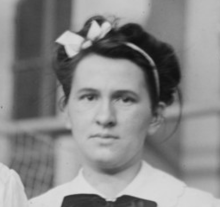 Wagner in 1913 | |
| Country (sports) | |
|---|---|
| Born | 2 February 1883 Freeport, New York, US |
| Died | 1 April 1975 (aged 92)[1] or 28 March 1975 (aged 92)[2] |
| Plays | Right-handed |
| Int. Tennis HoF | 1969 (member page) |
| Singles | |
| Grand Slam singles results | |
| US Open | F (1914) |
| Doubles | |
| Grand Slam doubles results | |
| US Open | QF (1914) |

Marie Wagner (February 2, 1883 – April 1, 1975[1] or March 28, 1975[2]) was an American tennis champion.
Biography[edit]
Wagner was born on February 2, 1883, in Freeport, New York. An outstanding tennis player, she won the United States Indoor Championships a record number of times. In the singles event, she won the title six times (1908, 1909, 1911, 1913, 1914, and 1917) while in doubles, she was successful in 1910, 1913 (with Clara Kutross), 1916 (with Molla Mallory) and in 1917 (with Margaret Taylor).[1]
At the U.S. National Championships, her best showing was reaching the final in 1914 which she lost in three sets to reigning champion Mary Browne.
Wagner was ranked in the Top 10 in the U.S. between 1913 (the first year women were ranked) and 1920. She achieved her highest national ranking of No.3 in 1914.[1]
She was inducted into the International Tennis Hall of Fame in 1969.[2] Wagner died in 1975.
Grand Slam finals[edit]
Singles (1 runner-up)[edit]
| Outcome | Year | Championship | Surface | Opponent | Score |
|---|---|---|---|---|---|
| Runner-up | 1914 | U.S. National Championships | Grass | 2–6, 6–1, 1–6 |
References[edit]
- ^ a b c d Collins, Bud (2016). The Bud Collins History of Tennis (3rd ed.). New York: New Chapter Press. p. 699. ISBN 978-1-937559-38-0.
- ^ a b c "Marie Wagner". International Tennis Hall of Fame. Retrieved 11 October 2013.
Well, that’s interesting to know that Psilotum nudum are known as whisk ferns. Psilotum nudum is the commoner species of the two. While the P. flaccidum is a rare species and is found in the tropical islands. Both the species are usually epiphytic in habit and grow upon tree ferns. These species may also be terrestrial and grow in humus or in the crevices of the rocks.
View the detailed Guide of Psilotum nudum: Detailed Study Of Psilotum Nudum (Whisk Fern), Classification, Anatomy, Reproduction